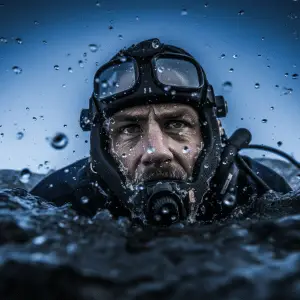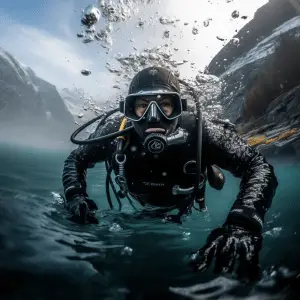Introduction: Understanding the Importance of Proper Equipment and Techniques for Cold Water Scuba Diving
Cold water scuba diving requires the right gear and techniques to be a safe and enjoyable experience. Knowing the importance of these is key for all divers. Exploring the icy depths shows how important it is to have the right knowledge and equipment for cold water diving.
A wing BCD is a must-have for cold water diving. This specialized gear lets divers control their buoyancy. It helps them move easily in chilly waters. Without this, divers could struggle to stay afloat, leading to discomfort and danger.
Cold water divers also need drysuits, hoods, gloves and insulated regulators. These items provide warmth and protection from the cold. Having the gear that fits well keeps divers warm and prevents hypothermia, so they can enjoy their dives.
Techniques are just as crucial. Divers must practice good breathing and equalization techniques. Colder water increases breathing rates, so conserving air and minimizing effort is important. Plus, mastering equalization methods helps divers descend without hurting their ears or feeling uncomfortable.
It’s also important to stay educated by taking courses and staying up-to-date with industry advancements. That way, you’ll have the best equipment and practices. Keeping educated ensures your safety and lets you explore new underwater environments with confidence.
Don’t miss out on the exciting opportunity of cold water scuba diving! Get the right knowledge, tools, and mindset and dive into the wonders hidden beneath the icy depths. Get ready for an amazing adventure!
Selecting the Right Wing BCD for Cold Water Diving

Selecting the right wing BCD for cold water diving is vital! A wing BCD, or buoyancy compensator device, is a crucial piece of scuba diving equipment that assists in controlling buoyancy underwater. Cold water diving has its own unique challenges, such as the requirement for insulation and durability.
When choosing a wing BCD for cold water dives, divers must prioritize features like thermal protection, weight capacity, and ease of use. Here’s a table summarizing important factors to consider:
| Feature | Description |
|---|---|
| Thermal Protection | Look for materials like neoprene or heavy-duty nylon for warmth |
| Weight Capacity | Ensure the BCD can support your gear and any additional weights |
| Durable Construction | Cold water can be harsh, so choose a BCD made from robust materials |
| Integrated Weight System | Simplifies adjusting buoyancy by having weights integrated into the BCD |
| Secure Fit | A snug and comfortable fit is essential to maintain proper buoyancy |
Personal preferences and diving style also play a role. Some divers may prefer back inflation BCDs over jacket-style ones, while others may prioritize added features like multiple D-rings or pockets.
Additionally, pay attention to the type of valves used in the BCD. Cold water can affect valve performance, so choose a BCD with freeze-resistant valves to prevent malfunctions during dives in chilly waters.
In the past, before specialized equipment became widely available, divers had to rely on improvised solutions to brave the cold waters. They would often use drysuit inflators or even life vests as makeshift buoyancy control devices.
Remember, selecting the right wing BCD is essential for a safe and comfortable cold water diving experience. Take into account the factors mentioned earlier, adapt them to your personal needs, and consult with experienced divers or professionals if needed. And don’t forget – the only thing colder than the water is the look on your face when your dive buddy steals your hot cocoa. Happy diving!
Preparing for Cold Water Diving: Essential Tips and Safety Precautions
Prep for cold water diving? Here’s how!
- Research the dive site
- Invest in proper gear
- Check your equipment
- Practice buoyancy control
- Stay hydrated and nourished
- Always dive with a buddy
Also, maintain good physical fitness levels!
When I explored Alaska’s icy waters, the marine life was stunning: colorful corals and hidden sea creatures. Even in the challenging cold, it was unforgettable. Just goes to show, cold water diving can be beautiful!
Managing Buoyancy and Weight Control in Cold Water Diving
Mastering buoyancy & weight control in cold water diving is key. It needs tech know-how & an understanding of the challenges it brings. Here are tips to consider:
- Correct weighting. Cold water affects gear’s buoyancy, so adjust weights. Determine land buoyancy, then add a few pounds for thick wetsuits.
- Gear selection. Go for a wing BCD, it provides better lift distribution, avoiding uncontrolled ascents/descents.
- Equalization techniques. Cold water affects airspaces in our body, so practice different equalization methods like jaw movements, Frenzel & valsalva maneuver.
- Efficient breathing. Cold water diving needs slow, deep breaths to conserve air & reduce exertion.
- Monitor depth & ascent rate. Check dive computers & depth gauges to keep safe limits & avoid decompression sickness risks.
- Drysuit considerations. Drysuits add buoyancy, counterbalance it with correct weighting & practice with it before diving.
Always do thorough pre-dive checks on yourself & equipment when cold water diving. Regularly review dive procedures & train to stay informed & confident in managing buoyancy.
Cold Water Diving Techniques and Best Practices

Brave the chilly depths! Cold water diving needs specific techniques and best practices to make sure of a safe and exciting experience. Here are three key points to keep in mind:
- Proper insulation: When diving in cold water, wearing a wing BCD (buoyancy control device) is vital. This type of BCD provides better insulation and buoyancy control than traditional jacket-style BCDs.
- Thermal protection: A drysuit or a wetsuit with sufficient insulation is essential for cold water dives. The decision depends on water temperature and personal preference. A drysuit offers complete protection from water, whereas a wetsuit gives thermal insulation when wet.
- Gear considerations: Cold water influences gear performance, so it’s essential to make necessary adjustments. Use regulators designed for cold water diving to prevent freezing. Also, check your gear before each dive and make sure proper maintenance is done.
In addition, use accessories such as hoods, gloves, and boots to provide extra protection from the cold temperatures. These accessories help minimize heat loss from the head, hands, and feet—areas that cool faster due to their larger surface area.
For successful cold water diving, here are some tips:
- Do proper pre-dive planning: Look into the dive site ahead of time, taking into account elements like water temperature, currents, visibility, and possible risks. Plan your dives suitably to maximize safety and enjoyment.
- Do detailed equipment checks: Examine all your gear thoroughly before each dive. Make sure regulators are functioning properly and free of ice buildup. Check drysuits or wetsuits for any signs of wear or damage that could weaken them.
- Stay hydrated and warm up between dives: Coldwater divers often overlook the importance of hydration as they feel less thirsty underwater. Drink lots of liquids before and after diving to prevent dehydration. Take breaks between dives to warm up by staying in a heated environment and drinking hot beverages. This helps maintain body temperature and boosts overall comfort.
By following these tips, your cold water diving experience can be significantly enhanced. Keep in mind, appropriate preparation, insulation, and equipment maintenance are essential to make the most of the wonders of the chilly waters. Stay safe, explore responsibly, and savor the thrill of cold water diving!
Conclusion: Enhancing Your Scuba Diving Experience through Proper Gear and Techniques for Cold Water Diving
For an amazing scuba diving experience in cold water, you need the right gear and techniques. A wing BCD is a must-have. It offers better buoyancy control, insulation, and stability. Drysuits are also great for thermal insulation, plus a hood and gloves keep your head and hands warm.
Mastering the correct techniques is vital. Controlled movements help save energy. Avoid fast ascents or descents to prevent decompression sickness. Also, plan shorter dives for less exposure to the cold.
To keep your body temperature regulated, hydration and nutrition are key. Drink lots of water to avoid hypothermia. High-energy foods replenish lost calories during long dives. Preparing this way guarantees a fantastic cold water dive!


Latest Comments